Drug Therapy
VerifiedAdded on 2023/03/31
|9
|3100
|157
AI Summary
This document discusses the case study of Kelly, a pregnant woman experiencing hyperemesis and sciatica pain. It explores the reasons for severe sciatica pain during pregnancy and the impact of liver dysfunction on drug metabolism. The use of metoclopramide and ondansetron for managing nausea and vomiting is also discussed, along with the endocrine factors contributing to vomiting during pregnancy.
Contribute Materials
Your contribution can guide someone’s learning journey. Share your
documents today.

Running head: DRUG THERAPY
Drug Therapy
Name of the Student
Name of the University
Author Note
Drug Therapy
Name of the Student
Name of the University
Author Note
Secure Best Marks with AI Grader
Need help grading? Try our AI Grader for instant feedback on your assignments.
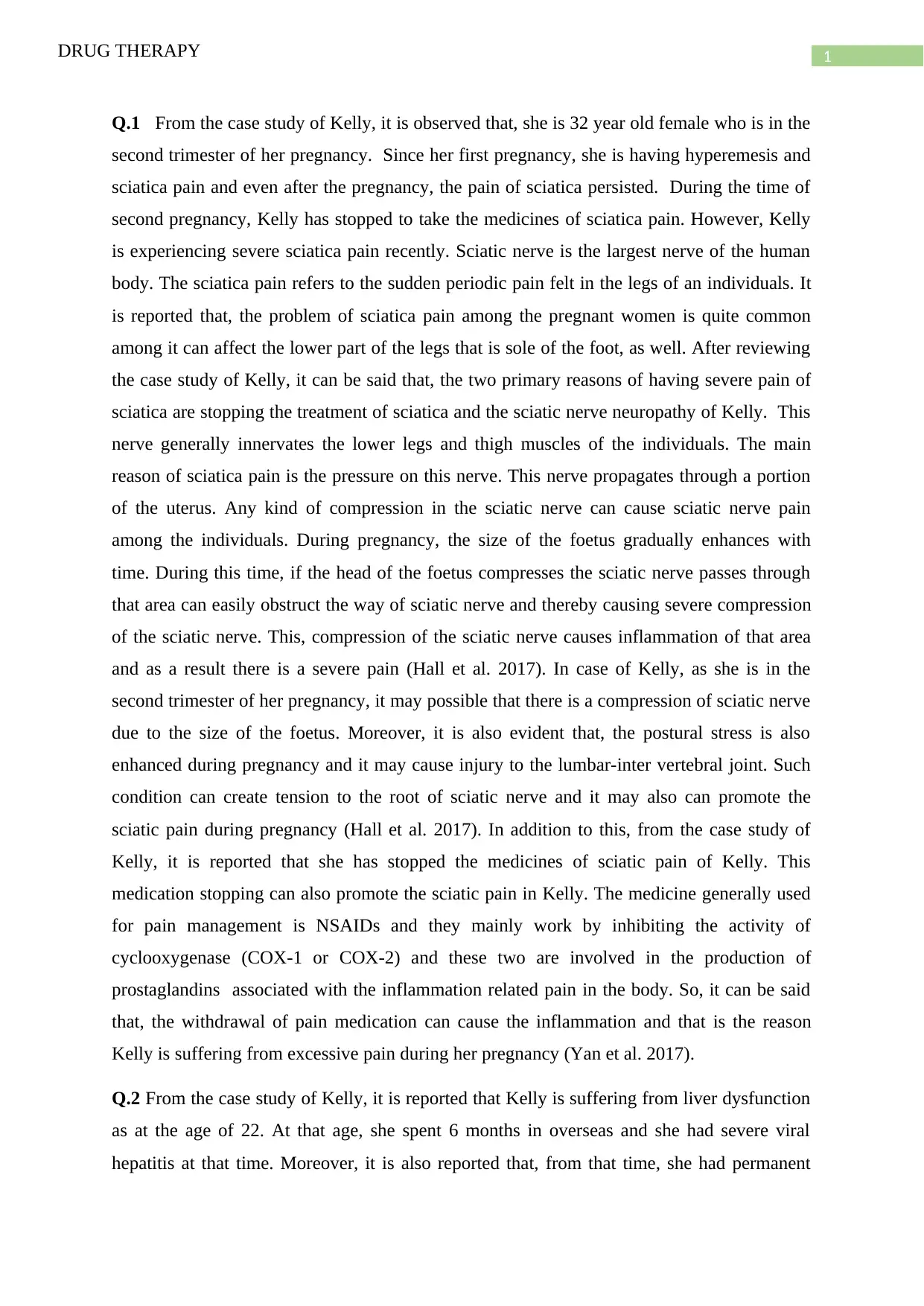
1DRUG THERAPY
Q.1 From the case study of Kelly, it is observed that, she is 32 year old female who is in the
second trimester of her pregnancy. Since her first pregnancy, she is having hyperemesis and
sciatica pain and even after the pregnancy, the pain of sciatica persisted. During the time of
second pregnancy, Kelly has stopped to take the medicines of sciatica pain. However, Kelly
is experiencing severe sciatica pain recently. Sciatic nerve is the largest nerve of the human
body. The sciatica pain refers to the sudden periodic pain felt in the legs of an individuals. It
is reported that, the problem of sciatica pain among the pregnant women is quite common
among it can affect the lower part of the legs that is sole of the foot, as well. After reviewing
the case study of Kelly, it can be said that, the two primary reasons of having severe pain of
sciatica are stopping the treatment of sciatica and the sciatic nerve neuropathy of Kelly. This
nerve generally innervates the lower legs and thigh muscles of the individuals. The main
reason of sciatica pain is the pressure on this nerve. This nerve propagates through a portion
of the uterus. Any kind of compression in the sciatic nerve can cause sciatic nerve pain
among the individuals. During pregnancy, the size of the foetus gradually enhances with
time. During this time, if the head of the foetus compresses the sciatic nerve passes through
that area can easily obstruct the way of sciatic nerve and thereby causing severe compression
of the sciatic nerve. This, compression of the sciatic nerve causes inflammation of that area
and as a result there is a severe pain (Hall et al. 2017). In case of Kelly, as she is in the
second trimester of her pregnancy, it may possible that there is a compression of sciatic nerve
due to the size of the foetus. Moreover, it is also evident that, the postural stress is also
enhanced during pregnancy and it may cause injury to the lumbar-inter vertebral joint. Such
condition can create tension to the root of sciatic nerve and it may also can promote the
sciatic pain during pregnancy (Hall et al. 2017). In addition to this, from the case study of
Kelly, it is reported that she has stopped the medicines of sciatic pain of Kelly. This
medication stopping can also promote the sciatic pain in Kelly. The medicine generally used
for pain management is NSAIDs and they mainly work by inhibiting the activity of
cyclooxygenase (COX-1 or COX-2) and these two are involved in the production of
prostaglandins associated with the inflammation related pain in the body. So, it can be said
that, the withdrawal of pain medication can cause the inflammation and that is the reason
Kelly is suffering from excessive pain during her pregnancy (Yan et al. 2017).
Q.2 From the case study of Kelly, it is reported that Kelly is suffering from liver dysfunction
as at the age of 22. At that age, she spent 6 months in overseas and she had severe viral
hepatitis at that time. Moreover, it is also reported that, from that time, she had permanent
Q.1 From the case study of Kelly, it is observed that, she is 32 year old female who is in the
second trimester of her pregnancy. Since her first pregnancy, she is having hyperemesis and
sciatica pain and even after the pregnancy, the pain of sciatica persisted. During the time of
second pregnancy, Kelly has stopped to take the medicines of sciatica pain. However, Kelly
is experiencing severe sciatica pain recently. Sciatic nerve is the largest nerve of the human
body. The sciatica pain refers to the sudden periodic pain felt in the legs of an individuals. It
is reported that, the problem of sciatica pain among the pregnant women is quite common
among it can affect the lower part of the legs that is sole of the foot, as well. After reviewing
the case study of Kelly, it can be said that, the two primary reasons of having severe pain of
sciatica are stopping the treatment of sciatica and the sciatic nerve neuropathy of Kelly. This
nerve generally innervates the lower legs and thigh muscles of the individuals. The main
reason of sciatica pain is the pressure on this nerve. This nerve propagates through a portion
of the uterus. Any kind of compression in the sciatic nerve can cause sciatic nerve pain
among the individuals. During pregnancy, the size of the foetus gradually enhances with
time. During this time, if the head of the foetus compresses the sciatic nerve passes through
that area can easily obstruct the way of sciatic nerve and thereby causing severe compression
of the sciatic nerve. This, compression of the sciatic nerve causes inflammation of that area
and as a result there is a severe pain (Hall et al. 2017). In case of Kelly, as she is in the
second trimester of her pregnancy, it may possible that there is a compression of sciatic nerve
due to the size of the foetus. Moreover, it is also evident that, the postural stress is also
enhanced during pregnancy and it may cause injury to the lumbar-inter vertebral joint. Such
condition can create tension to the root of sciatic nerve and it may also can promote the
sciatic pain during pregnancy (Hall et al. 2017). In addition to this, from the case study of
Kelly, it is reported that she has stopped the medicines of sciatic pain of Kelly. This
medication stopping can also promote the sciatic pain in Kelly. The medicine generally used
for pain management is NSAIDs and they mainly work by inhibiting the activity of
cyclooxygenase (COX-1 or COX-2) and these two are involved in the production of
prostaglandins associated with the inflammation related pain in the body. So, it can be said
that, the withdrawal of pain medication can cause the inflammation and that is the reason
Kelly is suffering from excessive pain during her pregnancy (Yan et al. 2017).
Q.2 From the case study of Kelly, it is reported that Kelly is suffering from liver dysfunction
as at the age of 22. At that age, she spent 6 months in overseas and she had severe viral
hepatitis at that time. Moreover, it is also reported that, from that time, she had permanent
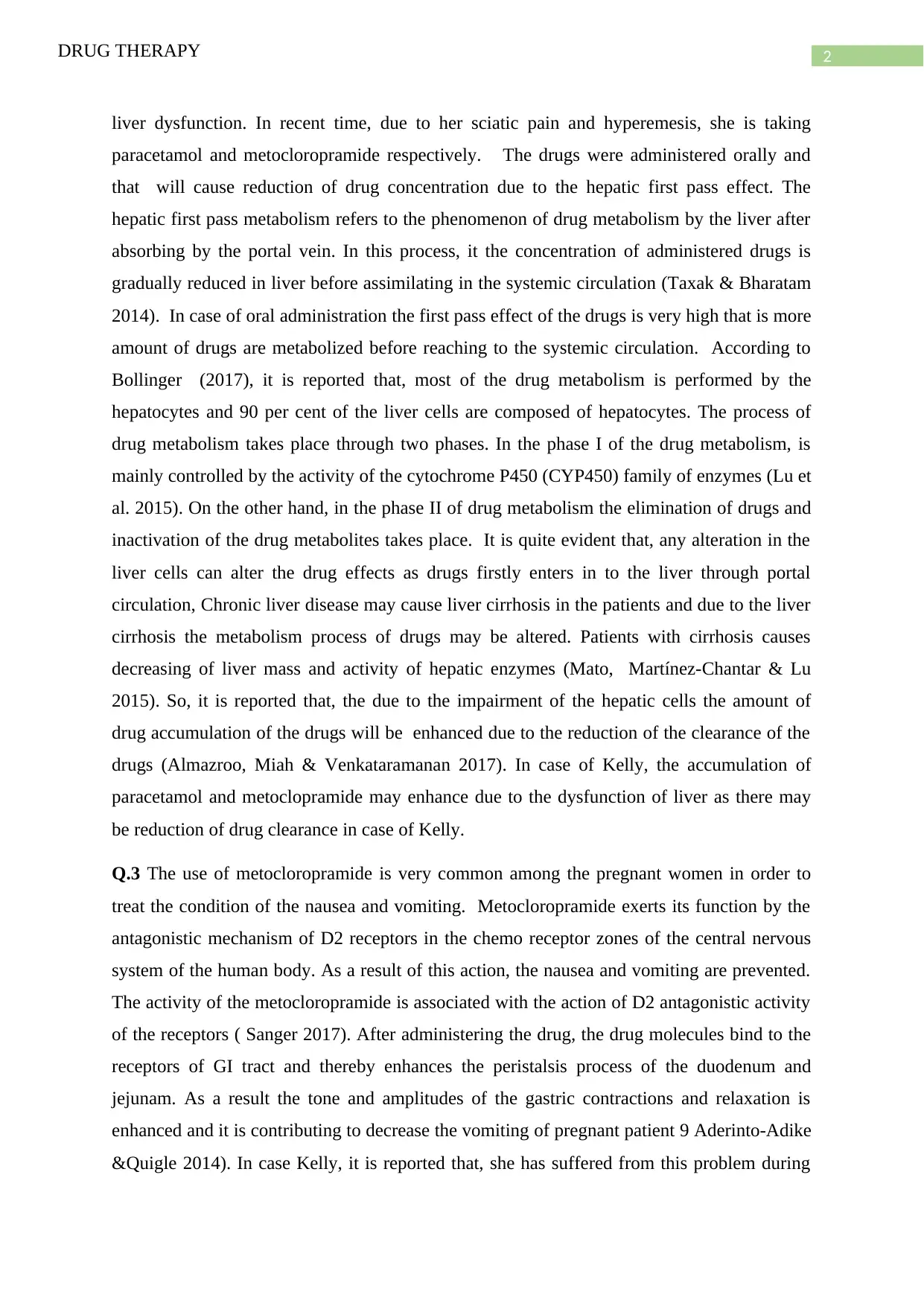
2DRUG THERAPY
liver dysfunction. In recent time, due to her sciatic pain and hyperemesis, she is taking
paracetamol and metocloropramide respectively. The drugs were administered orally and
that will cause reduction of drug concentration due to the hepatic first pass effect. The
hepatic first pass metabolism refers to the phenomenon of drug metabolism by the liver after
absorbing by the portal vein. In this process, it the concentration of administered drugs is
gradually reduced in liver before assimilating in the systemic circulation (Taxak & Bharatam
2014). In case of oral administration the first pass effect of the drugs is very high that is more
amount of drugs are metabolized before reaching to the systemic circulation. According to
Bollinger (2017), it is reported that, most of the drug metabolism is performed by the
hepatocytes and 90 per cent of the liver cells are composed of hepatocytes. The process of
drug metabolism takes place through two phases. In the phase I of the drug metabolism, is
mainly controlled by the activity of the cytochrome P450 (CYP450) family of enzymes (Lu et
al. 2015). On the other hand, in the phase II of drug metabolism the elimination of drugs and
inactivation of the drug metabolites takes place. It is quite evident that, any alteration in the
liver cells can alter the drug effects as drugs firstly enters in to the liver through portal
circulation, Chronic liver disease may cause liver cirrhosis in the patients and due to the liver
cirrhosis the metabolism process of drugs may be altered. Patients with cirrhosis causes
decreasing of liver mass and activity of hepatic enzymes (Mato, Martínez-Chantar & Lu
2015). So, it is reported that, the due to the impairment of the hepatic cells the amount of
drug accumulation of the drugs will be enhanced due to the reduction of the clearance of the
drugs (Almazroo, Miah & Venkataramanan 2017). In case of Kelly, the accumulation of
paracetamol and metoclopramide may enhance due to the dysfunction of liver as there may
be reduction of drug clearance in case of Kelly.
Q.3 The use of metocloropramide is very common among the pregnant women in order to
treat the condition of the nausea and vomiting. Metocloropramide exerts its function by the
antagonistic mechanism of D2 receptors in the chemo receptor zones of the central nervous
system of the human body. As a result of this action, the nausea and vomiting are prevented.
The activity of the metocloropramide is associated with the action of D2 antagonistic activity
of the receptors ( Sanger 2017). After administering the drug, the drug molecules bind to the
receptors of GI tract and thereby enhances the peristalsis process of the duodenum and
jejunam. As a result the tone and amplitudes of the gastric contractions and relaxation is
enhanced and it is contributing to decrease the vomiting of pregnant patient 9 Aderinto‐Adike
&Quigle 2014). In case Kelly, it is reported that, she has suffered from this problem during
liver dysfunction. In recent time, due to her sciatic pain and hyperemesis, she is taking
paracetamol and metocloropramide respectively. The drugs were administered orally and
that will cause reduction of drug concentration due to the hepatic first pass effect. The
hepatic first pass metabolism refers to the phenomenon of drug metabolism by the liver after
absorbing by the portal vein. In this process, it the concentration of administered drugs is
gradually reduced in liver before assimilating in the systemic circulation (Taxak & Bharatam
2014). In case of oral administration the first pass effect of the drugs is very high that is more
amount of drugs are metabolized before reaching to the systemic circulation. According to
Bollinger (2017), it is reported that, most of the drug metabolism is performed by the
hepatocytes and 90 per cent of the liver cells are composed of hepatocytes. The process of
drug metabolism takes place through two phases. In the phase I of the drug metabolism, is
mainly controlled by the activity of the cytochrome P450 (CYP450) family of enzymes (Lu et
al. 2015). On the other hand, in the phase II of drug metabolism the elimination of drugs and
inactivation of the drug metabolites takes place. It is quite evident that, any alteration in the
liver cells can alter the drug effects as drugs firstly enters in to the liver through portal
circulation, Chronic liver disease may cause liver cirrhosis in the patients and due to the liver
cirrhosis the metabolism process of drugs may be altered. Patients with cirrhosis causes
decreasing of liver mass and activity of hepatic enzymes (Mato, Martínez-Chantar & Lu
2015). So, it is reported that, the due to the impairment of the hepatic cells the amount of
drug accumulation of the drugs will be enhanced due to the reduction of the clearance of the
drugs (Almazroo, Miah & Venkataramanan 2017). In case of Kelly, the accumulation of
paracetamol and metoclopramide may enhance due to the dysfunction of liver as there may
be reduction of drug clearance in case of Kelly.
Q.3 The use of metocloropramide is very common among the pregnant women in order to
treat the condition of the nausea and vomiting. Metocloropramide exerts its function by the
antagonistic mechanism of D2 receptors in the chemo receptor zones of the central nervous
system of the human body. As a result of this action, the nausea and vomiting are prevented.
The activity of the metocloropramide is associated with the action of D2 antagonistic activity
of the receptors ( Sanger 2017). After administering the drug, the drug molecules bind to the
receptors of GI tract and thereby enhances the peristalsis process of the duodenum and
jejunam. As a result the tone and amplitudes of the gastric contractions and relaxation is
enhanced and it is contributing to decrease the vomiting of pregnant patient 9 Aderinto‐Adike
&Quigle 2014). In case Kelly, it is reported that, she has suffered from this problem during
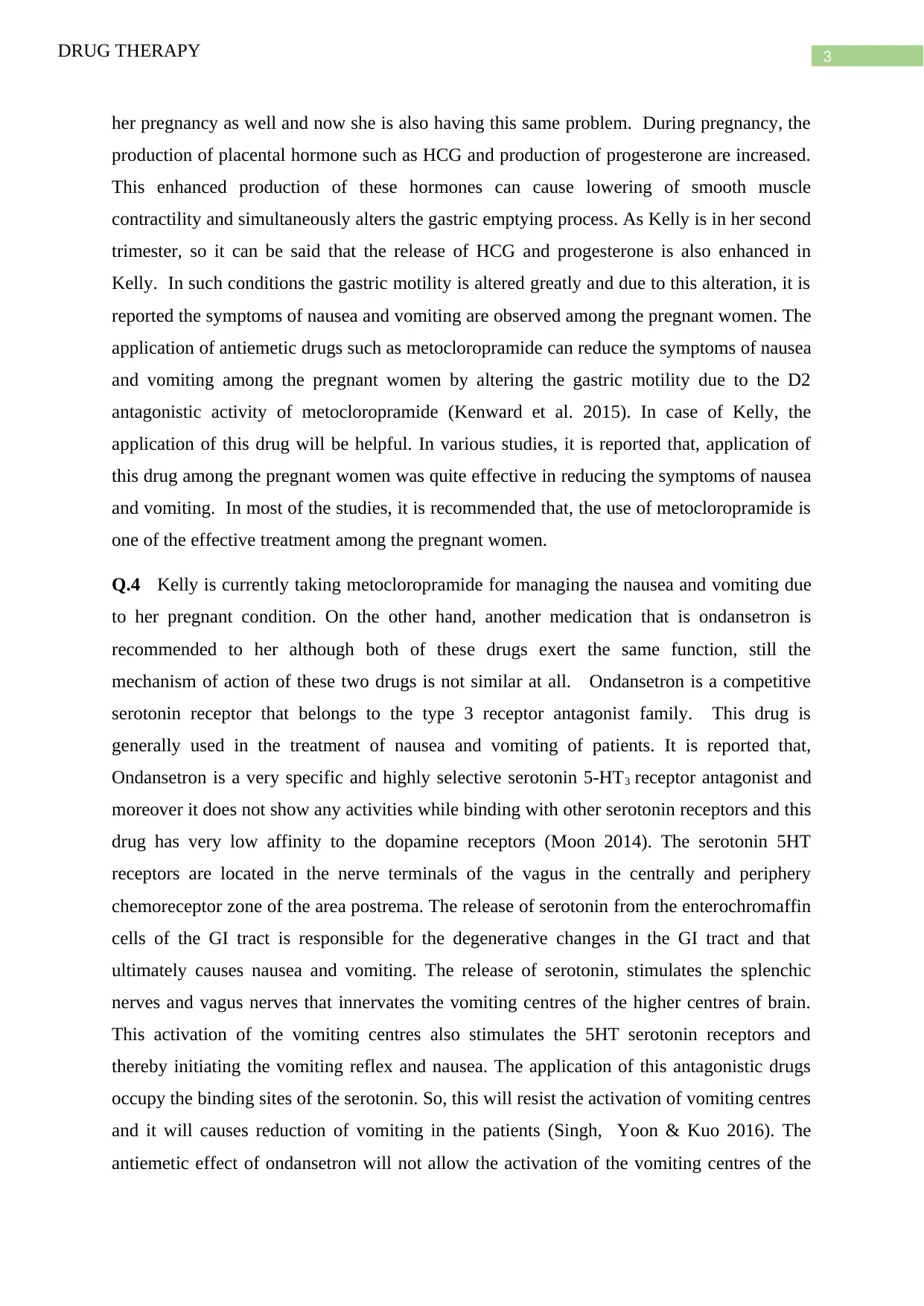
3DRUG THERAPY
her pregnancy as well and now she is also having this same problem. During pregnancy, the
production of placental hormone such as HCG and production of progesterone are increased.
This enhanced production of these hormones can cause lowering of smooth muscle
contractility and simultaneously alters the gastric emptying process. As Kelly is in her second
trimester, so it can be said that the release of HCG and progesterone is also enhanced in
Kelly. In such conditions the gastric motility is altered greatly and due to this alteration, it is
reported the symptoms of nausea and vomiting are observed among the pregnant women. The
application of antiemetic drugs such as metocloropramide can reduce the symptoms of nausea
and vomiting among the pregnant women by altering the gastric motility due to the D2
antagonistic activity of metocloropramide (Kenward et al. 2015). In case of Kelly, the
application of this drug will be helpful. In various studies, it is reported that, application of
this drug among the pregnant women was quite effective in reducing the symptoms of nausea
and vomiting. In most of the studies, it is recommended that, the use of metocloropramide is
one of the effective treatment among the pregnant women.
Q.4 Kelly is currently taking metocloropramide for managing the nausea and vomiting due
to her pregnant condition. On the other hand, another medication that is ondansetron is
recommended to her although both of these drugs exert the same function, still the
mechanism of action of these two drugs is not similar at all. Ondansetron is a competitive
serotonin receptor that belongs to the type 3 receptor antagonist family. This drug is
generally used in the treatment of nausea and vomiting of patients. It is reported that,
Ondansetron is a very specific and highly selective serotonin 5-HT3 receptor antagonist and
moreover it does not show any activities while binding with other serotonin receptors and this
drug has very low affinity to the dopamine receptors (Moon 2014). The serotonin 5HT
receptors are located in the nerve terminals of the vagus in the centrally and periphery
chemoreceptor zone of the area postrema. The release of serotonin from the enterochromaffin
cells of the GI tract is responsible for the degenerative changes in the GI tract and that
ultimately causes nausea and vomiting. The release of serotonin, stimulates the splenchic
nerves and vagus nerves that innervates the vomiting centres of the higher centres of brain.
This activation of the vomiting centres also stimulates the 5HT serotonin receptors and
thereby initiating the vomiting reflex and nausea. The application of this antagonistic drugs
occupy the binding sites of the serotonin. So, this will resist the activation of vomiting centres
and it will causes reduction of vomiting in the patients (Singh, Yoon & Kuo 2016). The
antiemetic effect of ondansetron will not allow the activation of the vomiting centres of the
her pregnancy as well and now she is also having this same problem. During pregnancy, the
production of placental hormone such as HCG and production of progesterone are increased.
This enhanced production of these hormones can cause lowering of smooth muscle
contractility and simultaneously alters the gastric emptying process. As Kelly is in her second
trimester, so it can be said that the release of HCG and progesterone is also enhanced in
Kelly. In such conditions the gastric motility is altered greatly and due to this alteration, it is
reported the symptoms of nausea and vomiting are observed among the pregnant women. The
application of antiemetic drugs such as metocloropramide can reduce the symptoms of nausea
and vomiting among the pregnant women by altering the gastric motility due to the D2
antagonistic activity of metocloropramide (Kenward et al. 2015). In case of Kelly, the
application of this drug will be helpful. In various studies, it is reported that, application of
this drug among the pregnant women was quite effective in reducing the symptoms of nausea
and vomiting. In most of the studies, it is recommended that, the use of metocloropramide is
one of the effective treatment among the pregnant women.
Q.4 Kelly is currently taking metocloropramide for managing the nausea and vomiting due
to her pregnant condition. On the other hand, another medication that is ondansetron is
recommended to her although both of these drugs exert the same function, still the
mechanism of action of these two drugs is not similar at all. Ondansetron is a competitive
serotonin receptor that belongs to the type 3 receptor antagonist family. This drug is
generally used in the treatment of nausea and vomiting of patients. It is reported that,
Ondansetron is a very specific and highly selective serotonin 5-HT3 receptor antagonist and
moreover it does not show any activities while binding with other serotonin receptors and this
drug has very low affinity to the dopamine receptors (Moon 2014). The serotonin 5HT
receptors are located in the nerve terminals of the vagus in the centrally and periphery
chemoreceptor zone of the area postrema. The release of serotonin from the enterochromaffin
cells of the GI tract is responsible for the degenerative changes in the GI tract and that
ultimately causes nausea and vomiting. The release of serotonin, stimulates the splenchic
nerves and vagus nerves that innervates the vomiting centres of the higher centres of brain.
This activation of the vomiting centres also stimulates the 5HT serotonin receptors and
thereby initiating the vomiting reflex and nausea. The application of this antagonistic drugs
occupy the binding sites of the serotonin. So, this will resist the activation of vomiting centres
and it will causes reduction of vomiting in the patients (Singh, Yoon & Kuo 2016). The
antiemetic effect of ondansetron will not allow the activation of the vomiting centres of the
Secure Best Marks with AI Grader
Need help grading? Try our AI Grader for instant feedback on your assignments.
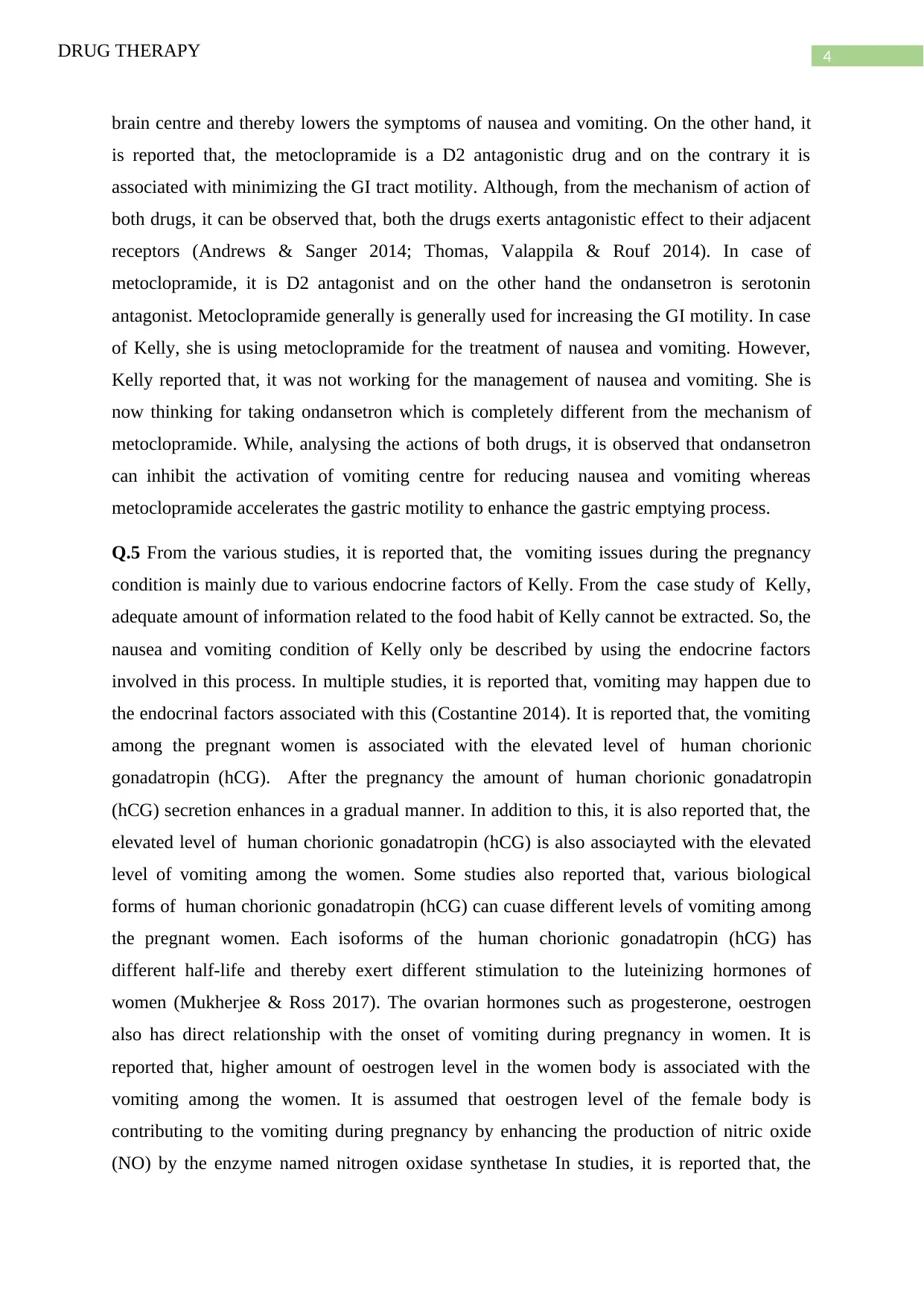
4DRUG THERAPY
brain centre and thereby lowers the symptoms of nausea and vomiting. On the other hand, it
is reported that, the metoclopramide is a D2 antagonistic drug and on the contrary it is
associated with minimizing the GI tract motility. Although, from the mechanism of action of
both drugs, it can be observed that, both the drugs exerts antagonistic effect to their adjacent
receptors (Andrews & Sanger 2014; Thomas, Valappila & Rouf 2014). In case of
metoclopramide, it is D2 antagonist and on the other hand the ondansetron is serotonin
antagonist. Metoclopramide generally is generally used for increasing the GI motility. In case
of Kelly, she is using metoclopramide for the treatment of nausea and vomiting. However,
Kelly reported that, it was not working for the management of nausea and vomiting. She is
now thinking for taking ondansetron which is completely different from the mechanism of
metoclopramide. While, analysing the actions of both drugs, it is observed that ondansetron
can inhibit the activation of vomiting centre for reducing nausea and vomiting whereas
metoclopramide accelerates the gastric motility to enhance the gastric emptying process.
Q.5 From the various studies, it is reported that, the vomiting issues during the pregnancy
condition is mainly due to various endocrine factors of Kelly. From the case study of Kelly,
adequate amount of information related to the food habit of Kelly cannot be extracted. So, the
nausea and vomiting condition of Kelly only be described by using the endocrine factors
involved in this process. In multiple studies, it is reported that, vomiting may happen due to
the endocrinal factors associated with this (Costantine 2014). It is reported that, the vomiting
among the pregnant women is associated with the elevated level of human chorionic
gonadatropin (hCG). After the pregnancy the amount of human chorionic gonadatropin
(hCG) secretion enhances in a gradual manner. In addition to this, it is also reported that, the
elevated level of human chorionic gonadatropin (hCG) is also associayted with the elevated
level of vomiting among the women. Some studies also reported that, various biological
forms of human chorionic gonadatropin (hCG) can cuase different levels of vomiting among
the pregnant women. Each isoforms of the human chorionic gonadatropin (hCG) has
different half-life and thereby exert different stimulation to the luteinizing hormones of
women (Mukherjee & Ross 2017). The ovarian hormones such as progesterone, oestrogen
also has direct relationship with the onset of vomiting during pregnancy in women. It is
reported that, higher amount of oestrogen level in the women body is associated with the
vomiting among the women. It is assumed that oestrogen level of the female body is
contributing to the vomiting during pregnancy by enhancing the production of nitric oxide
(NO) by the enzyme named nitrogen oxidase synthetase In studies, it is reported that, the
brain centre and thereby lowers the symptoms of nausea and vomiting. On the other hand, it
is reported that, the metoclopramide is a D2 antagonistic drug and on the contrary it is
associated with minimizing the GI tract motility. Although, from the mechanism of action of
both drugs, it can be observed that, both the drugs exerts antagonistic effect to their adjacent
receptors (Andrews & Sanger 2014; Thomas, Valappila & Rouf 2014). In case of
metoclopramide, it is D2 antagonist and on the other hand the ondansetron is serotonin
antagonist. Metoclopramide generally is generally used for increasing the GI motility. In case
of Kelly, she is using metoclopramide for the treatment of nausea and vomiting. However,
Kelly reported that, it was not working for the management of nausea and vomiting. She is
now thinking for taking ondansetron which is completely different from the mechanism of
metoclopramide. While, analysing the actions of both drugs, it is observed that ondansetron
can inhibit the activation of vomiting centre for reducing nausea and vomiting whereas
metoclopramide accelerates the gastric motility to enhance the gastric emptying process.
Q.5 From the various studies, it is reported that, the vomiting issues during the pregnancy
condition is mainly due to various endocrine factors of Kelly. From the case study of Kelly,
adequate amount of information related to the food habit of Kelly cannot be extracted. So, the
nausea and vomiting condition of Kelly only be described by using the endocrine factors
involved in this process. In multiple studies, it is reported that, vomiting may happen due to
the endocrinal factors associated with this (Costantine 2014). It is reported that, the vomiting
among the pregnant women is associated with the elevated level of human chorionic
gonadatropin (hCG). After the pregnancy the amount of human chorionic gonadatropin
(hCG) secretion enhances in a gradual manner. In addition to this, it is also reported that, the
elevated level of human chorionic gonadatropin (hCG) is also associayted with the elevated
level of vomiting among the women. Some studies also reported that, various biological
forms of human chorionic gonadatropin (hCG) can cuase different levels of vomiting among
the pregnant women. Each isoforms of the human chorionic gonadatropin (hCG) has
different half-life and thereby exert different stimulation to the luteinizing hormones of
women (Mukherjee & Ross 2017). The ovarian hormones such as progesterone, oestrogen
also has direct relationship with the onset of vomiting during pregnancy in women. It is
reported that, higher amount of oestrogen level in the women body is associated with the
vomiting among the women. It is assumed that oestrogen level of the female body is
contributing to the vomiting during pregnancy by enhancing the production of nitric oxide
(NO) by the enzyme named nitrogen oxidase synthetase In studies, it is reported that, the
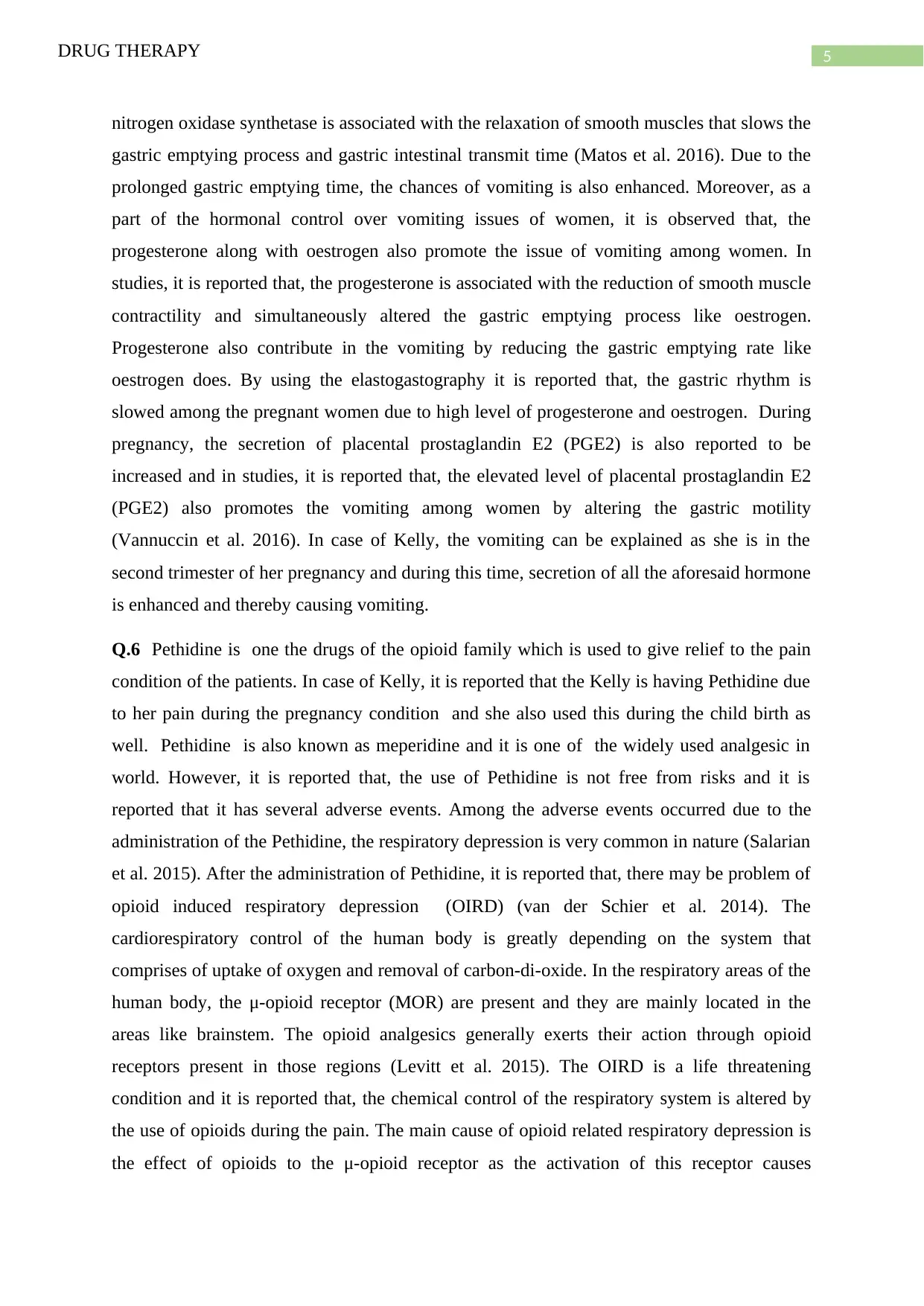
5DRUG THERAPY
nitrogen oxidase synthetase is associated with the relaxation of smooth muscles that slows the
gastric emptying process and gastric intestinal transmit time (Matos et al. 2016). Due to the
prolonged gastric emptying time, the chances of vomiting is also enhanced. Moreover, as a
part of the hormonal control over vomiting issues of women, it is observed that, the
progesterone along with oestrogen also promote the issue of vomiting among women. In
studies, it is reported that, the progesterone is associated with the reduction of smooth muscle
contractility and simultaneously altered the gastric emptying process like oestrogen.
Progesterone also contribute in the vomiting by reducing the gastric emptying rate like
oestrogen does. By using the elastogastography it is reported that, the gastric rhythm is
slowed among the pregnant women due to high level of progesterone and oestrogen. During
pregnancy, the secretion of placental prostaglandin E2 (PGE2) is also reported to be
increased and in studies, it is reported that, the elevated level of placental prostaglandin E2
(PGE2) also promotes the vomiting among women by altering the gastric motility
(Vannuccin et al. 2016). In case of Kelly, the vomiting can be explained as she is in the
second trimester of her pregnancy and during this time, secretion of all the aforesaid hormone
is enhanced and thereby causing vomiting.
Q.6 Pethidine is one the drugs of the opioid family which is used to give relief to the pain
condition of the patients. In case of Kelly, it is reported that the Kelly is having Pethidine due
to her pain during the pregnancy condition and she also used this during the child birth as
well. Pethidine is also known as meperidine and it is one of the widely used analgesic in
world. However, it is reported that, the use of Pethidine is not free from risks and it is
reported that it has several adverse events. Among the adverse events occurred due to the
administration of the Pethidine, the respiratory depression is very common in nature (Salarian
et al. 2015). After the administration of Pethidine, it is reported that, there may be problem of
opioid induced respiratory depression (OIRD) (van der Schier et al. 2014). The
cardiorespiratory control of the human body is greatly depending on the system that
comprises of uptake of oxygen and removal of carbon-di-oxide. In the respiratory areas of the
human body, the μ-opioid receptor (MOR) are present and they are mainly located in the
areas like brainstem. The opioid analgesics generally exerts their action through opioid
receptors present in those regions (Levitt et al. 2015). The OIRD is a life threatening
condition and it is reported that, the chemical control of the respiratory system is altered by
the use of opioids during the pain. The main cause of opioid related respiratory depression is
the effect of opioids to the μ-opioid receptor as the activation of this receptor causes
nitrogen oxidase synthetase is associated with the relaxation of smooth muscles that slows the
gastric emptying process and gastric intestinal transmit time (Matos et al. 2016). Due to the
prolonged gastric emptying time, the chances of vomiting is also enhanced. Moreover, as a
part of the hormonal control over vomiting issues of women, it is observed that, the
progesterone along with oestrogen also promote the issue of vomiting among women. In
studies, it is reported that, the progesterone is associated with the reduction of smooth muscle
contractility and simultaneously altered the gastric emptying process like oestrogen.
Progesterone also contribute in the vomiting by reducing the gastric emptying rate like
oestrogen does. By using the elastogastography it is reported that, the gastric rhythm is
slowed among the pregnant women due to high level of progesterone and oestrogen. During
pregnancy, the secretion of placental prostaglandin E2 (PGE2) is also reported to be
increased and in studies, it is reported that, the elevated level of placental prostaglandin E2
(PGE2) also promotes the vomiting among women by altering the gastric motility
(Vannuccin et al. 2016). In case of Kelly, the vomiting can be explained as she is in the
second trimester of her pregnancy and during this time, secretion of all the aforesaid hormone
is enhanced and thereby causing vomiting.
Q.6 Pethidine is one the drugs of the opioid family which is used to give relief to the pain
condition of the patients. In case of Kelly, it is reported that the Kelly is having Pethidine due
to her pain during the pregnancy condition and she also used this during the child birth as
well. Pethidine is also known as meperidine and it is one of the widely used analgesic in
world. However, it is reported that, the use of Pethidine is not free from risks and it is
reported that it has several adverse events. Among the adverse events occurred due to the
administration of the Pethidine, the respiratory depression is very common in nature (Salarian
et al. 2015). After the administration of Pethidine, it is reported that, there may be problem of
opioid induced respiratory depression (OIRD) (van der Schier et al. 2014). The
cardiorespiratory control of the human body is greatly depending on the system that
comprises of uptake of oxygen and removal of carbon-di-oxide. In the respiratory areas of the
human body, the μ-opioid receptor (MOR) are present and they are mainly located in the
areas like brainstem. The opioid analgesics generally exerts their action through opioid
receptors present in those regions (Levitt et al. 2015). The OIRD is a life threatening
condition and it is reported that, the chemical control of the respiratory system is altered by
the use of opioids during the pain. The main cause of opioid related respiratory depression is
the effect of opioids to the μ-opioid receptor as the activation of this receptor causes
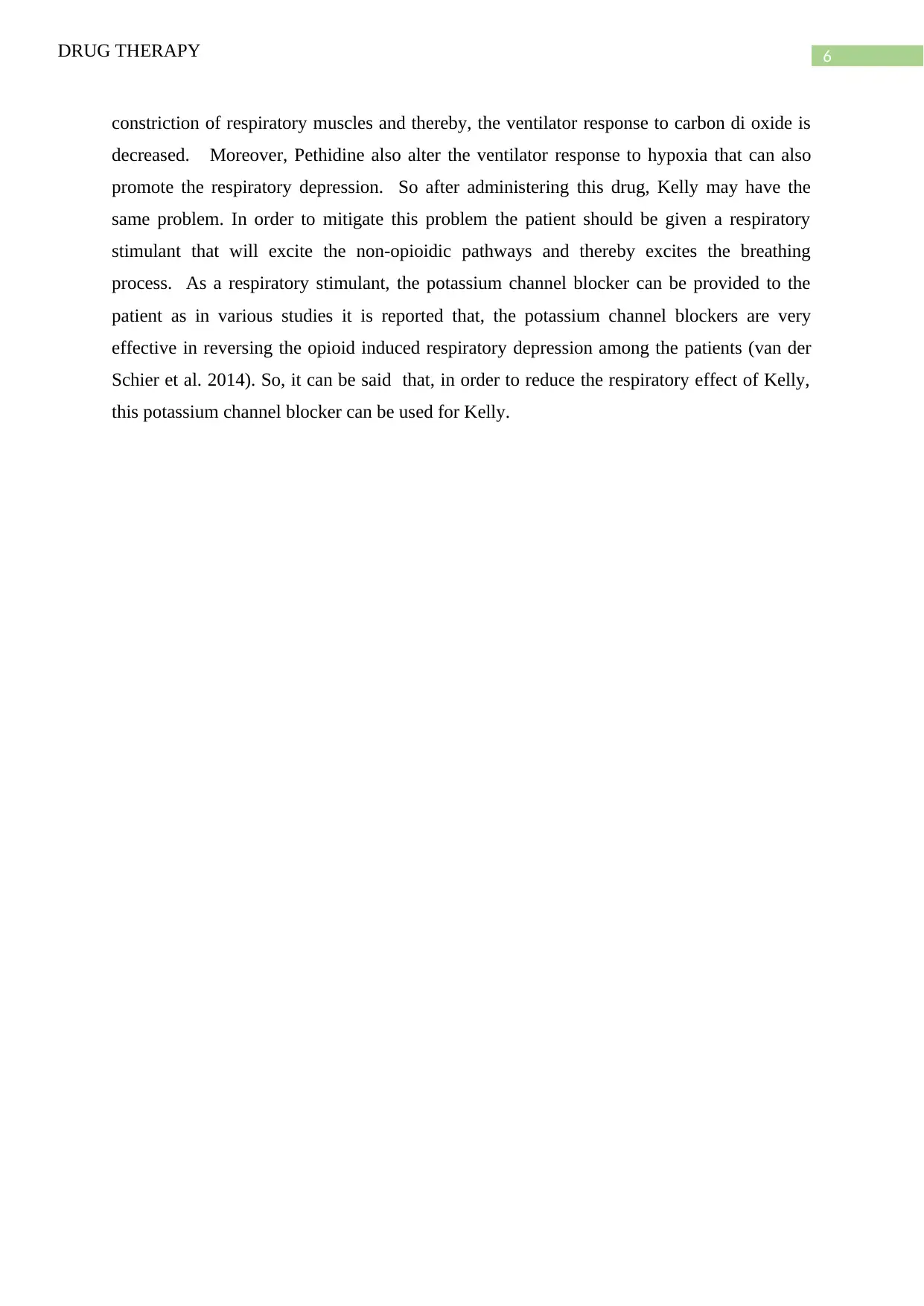
6DRUG THERAPY
constriction of respiratory muscles and thereby, the ventilator response to carbon di oxide is
decreased. Moreover, Pethidine also alter the ventilator response to hypoxia that can also
promote the respiratory depression. So after administering this drug, Kelly may have the
same problem. In order to mitigate this problem the patient should be given a respiratory
stimulant that will excite the non-opioidic pathways and thereby excites the breathing
process. As a respiratory stimulant, the potassium channel blocker can be provided to the
patient as in various studies it is reported that, the potassium channel blockers are very
effective in reversing the opioid induced respiratory depression among the patients (van der
Schier et al. 2014). So, it can be said that, in order to reduce the respiratory effect of Kelly,
this potassium channel blocker can be used for Kelly.
constriction of respiratory muscles and thereby, the ventilator response to carbon di oxide is
decreased. Moreover, Pethidine also alter the ventilator response to hypoxia that can also
promote the respiratory depression. So after administering this drug, Kelly may have the
same problem. In order to mitigate this problem the patient should be given a respiratory
stimulant that will excite the non-opioidic pathways and thereby excites the breathing
process. As a respiratory stimulant, the potassium channel blocker can be provided to the
patient as in various studies it is reported that, the potassium channel blockers are very
effective in reversing the opioid induced respiratory depression among the patients (van der
Schier et al. 2014). So, it can be said that, in order to reduce the respiratory effect of Kelly,
this potassium channel blocker can be used for Kelly.
Paraphrase This Document
Need a fresh take? Get an instant paraphrase of this document with our AI Paraphraser
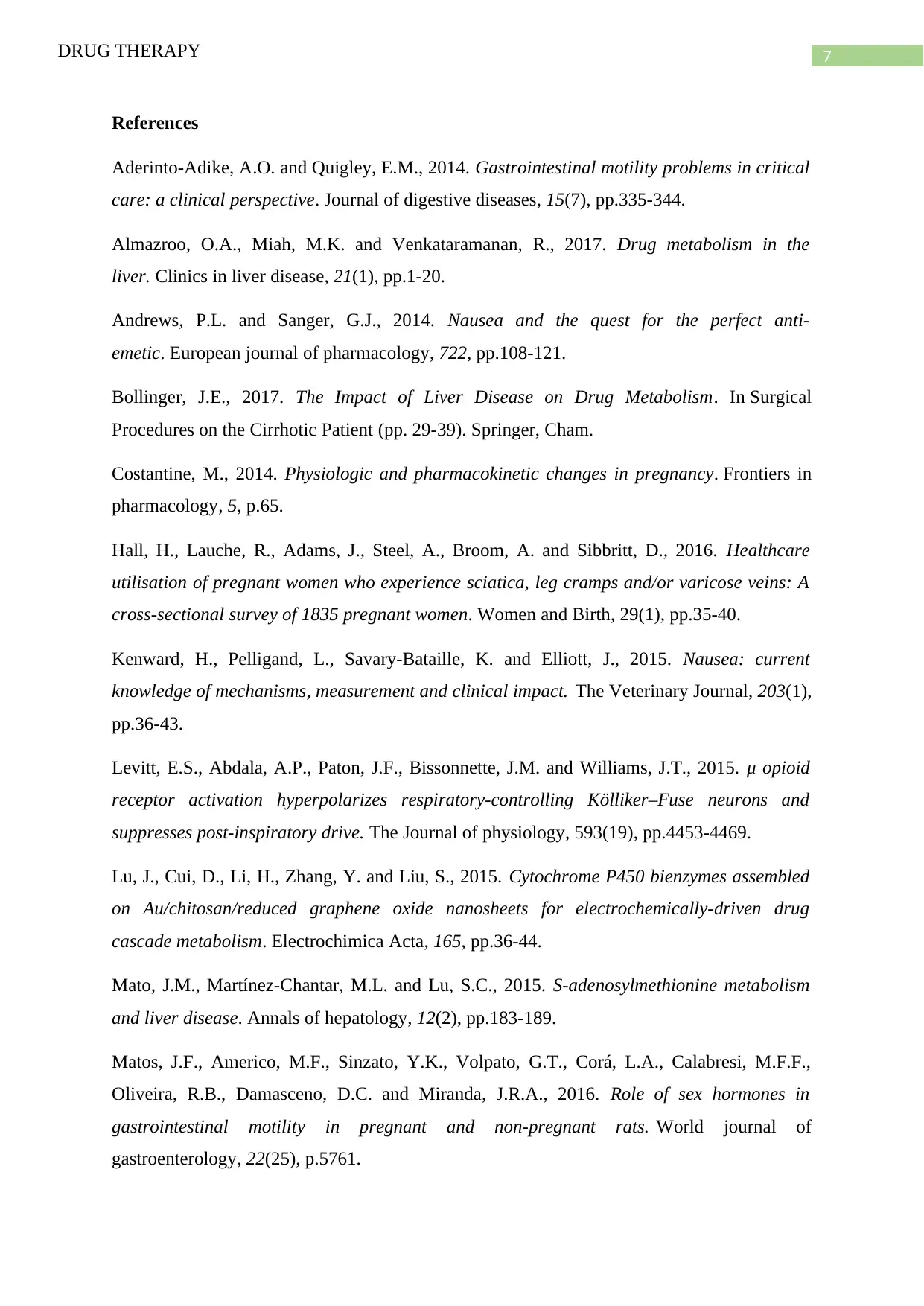
7DRUG THERAPY
References
Aderinto‐Adike, A.O. and Quigley, E.M., 2014. Gastrointestinal motility problems in critical
care: a clinical perspective. Journal of digestive diseases, 15(7), pp.335-344.
Almazroo, O.A., Miah, M.K. and Venkataramanan, R., 2017. Drug metabolism in the
liver. Clinics in liver disease, 21(1), pp.1-20.
Andrews, P.L. and Sanger, G.J., 2014. Nausea and the quest for the perfect anti-
emetic. European journal of pharmacology, 722, pp.108-121.
Bollinger, J.E., 2017. The Impact of Liver Disease on Drug Metabolism. In Surgical
Procedures on the Cirrhotic Patient (pp. 29-39). Springer, Cham.
Costantine, M., 2014. Physiologic and pharmacokinetic changes in pregnancy. Frontiers in
pharmacology, 5, p.65.
Hall, H., Lauche, R., Adams, J., Steel, A., Broom, A. and Sibbritt, D., 2016. Healthcare
utilisation of pregnant women who experience sciatica, leg cramps and/or varicose veins: A
cross-sectional survey of 1835 pregnant women. Women and Birth, 29(1), pp.35-40.
Kenward, H., Pelligand, L., Savary-Bataille, K. and Elliott, J., 2015. Nausea: current
knowledge of mechanisms, measurement and clinical impact. The Veterinary Journal, 203(1),
pp.36-43.
Levitt, E.S., Abdala, A.P., Paton, J.F., Bissonnette, J.M. and Williams, J.T., 2015. μ opioid
receptor activation hyperpolarizes respiratory‐controlling Kölliker–Fuse neurons and
suppresses post‐inspiratory drive. The Journal of physiology, 593(19), pp.4453-4469.
Lu, J., Cui, D., Li, H., Zhang, Y. and Liu, S., 2015. Cytochrome P450 bienzymes assembled
on Au/chitosan/reduced graphene oxide nanosheets for electrochemically-driven drug
cascade metabolism. Electrochimica Acta, 165, pp.36-44.
Mato, J.M., Martínez-Chantar, M.L. and Lu, S.C., 2015. S-adenosylmethionine metabolism
and liver disease. Annals of hepatology, 12(2), pp.183-189.
Matos, J.F., Americo, M.F., Sinzato, Y.K., Volpato, G.T., Corá, L.A., Calabresi, M.F.F.,
Oliveira, R.B., Damasceno, D.C. and Miranda, J.R.A., 2016. Role of sex hormones in
gastrointestinal motility in pregnant and non-pregnant rats. World journal of
gastroenterology, 22(25), p.5761.
References
Aderinto‐Adike, A.O. and Quigley, E.M., 2014. Gastrointestinal motility problems in critical
care: a clinical perspective. Journal of digestive diseases, 15(7), pp.335-344.
Almazroo, O.A., Miah, M.K. and Venkataramanan, R., 2017. Drug metabolism in the
liver. Clinics in liver disease, 21(1), pp.1-20.
Andrews, P.L. and Sanger, G.J., 2014. Nausea and the quest for the perfect anti-
emetic. European journal of pharmacology, 722, pp.108-121.
Bollinger, J.E., 2017. The Impact of Liver Disease on Drug Metabolism. In Surgical
Procedures on the Cirrhotic Patient (pp. 29-39). Springer, Cham.
Costantine, M., 2014. Physiologic and pharmacokinetic changes in pregnancy. Frontiers in
pharmacology, 5, p.65.
Hall, H., Lauche, R., Adams, J., Steel, A., Broom, A. and Sibbritt, D., 2016. Healthcare
utilisation of pregnant women who experience sciatica, leg cramps and/or varicose veins: A
cross-sectional survey of 1835 pregnant women. Women and Birth, 29(1), pp.35-40.
Kenward, H., Pelligand, L., Savary-Bataille, K. and Elliott, J., 2015. Nausea: current
knowledge of mechanisms, measurement and clinical impact. The Veterinary Journal, 203(1),
pp.36-43.
Levitt, E.S., Abdala, A.P., Paton, J.F., Bissonnette, J.M. and Williams, J.T., 2015. μ opioid
receptor activation hyperpolarizes respiratory‐controlling Kölliker–Fuse neurons and
suppresses post‐inspiratory drive. The Journal of physiology, 593(19), pp.4453-4469.
Lu, J., Cui, D., Li, H., Zhang, Y. and Liu, S., 2015. Cytochrome P450 bienzymes assembled
on Au/chitosan/reduced graphene oxide nanosheets for electrochemically-driven drug
cascade metabolism. Electrochimica Acta, 165, pp.36-44.
Mato, J.M., Martínez-Chantar, M.L. and Lu, S.C., 2015. S-adenosylmethionine metabolism
and liver disease. Annals of hepatology, 12(2), pp.183-189.
Matos, J.F., Americo, M.F., Sinzato, Y.K., Volpato, G.T., Corá, L.A., Calabresi, M.F.F.,
Oliveira, R.B., Damasceno, D.C. and Miranda, J.R.A., 2016. Role of sex hormones in
gastrointestinal motility in pregnant and non-pregnant rats. World journal of
gastroenterology, 22(25), p.5761.
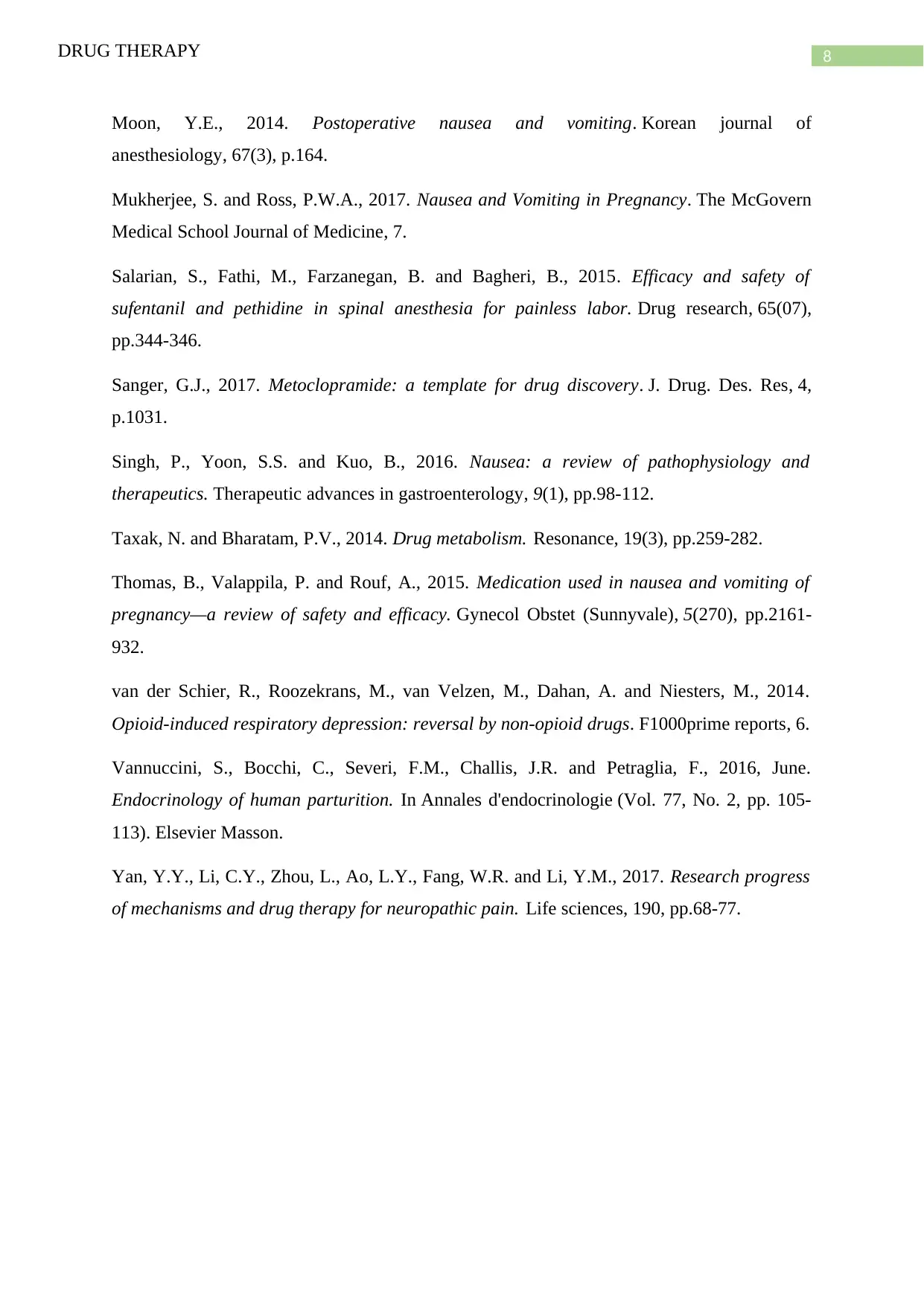
8DRUG THERAPY
Moon, Y.E., 2014. Postoperative nausea and vomiting. Korean journal of
anesthesiology, 67(3), p.164.
Mukherjee, S. and Ross, P.W.A., 2017. Nausea and Vomiting in Pregnancy. The McGovern
Medical School Journal of Medicine, 7.
Salarian, S., Fathi, M., Farzanegan, B. and Bagheri, B., 2015. Efficacy and safety of
sufentanil and pethidine in spinal anesthesia for painless labor. Drug research, 65(07),
pp.344-346.
Sanger, G.J., 2017. Metoclopramide: a template for drug discovery. J. Drug. Des. Res, 4,
p.1031.
Singh, P., Yoon, S.S. and Kuo, B., 2016. Nausea: a review of pathophysiology and
therapeutics. Therapeutic advances in gastroenterology, 9(1), pp.98-112.
Taxak, N. and Bharatam, P.V., 2014. Drug metabolism. Resonance, 19(3), pp.259-282.
Thomas, B., Valappila, P. and Rouf, A., 2015. Medication used in nausea and vomiting of
pregnancy—a review of safety and efficacy. Gynecol Obstet (Sunnyvale), 5(270), pp.2161-
932.
van der Schier, R., Roozekrans, M., van Velzen, M., Dahan, A. and Niesters, M., 2014.
Opioid-induced respiratory depression: reversal by non-opioid drugs. F1000prime reports, 6.
Vannuccini, S., Bocchi, C., Severi, F.M., Challis, J.R. and Petraglia, F., 2016, June.
Endocrinology of human parturition. In Annales d'endocrinologie (Vol. 77, No. 2, pp. 105-
113). Elsevier Masson.
Yan, Y.Y., Li, C.Y., Zhou, L., Ao, L.Y., Fang, W.R. and Li, Y.M., 2017. Research progress
of mechanisms and drug therapy for neuropathic pain. Life sciences, 190, pp.68-77.
Moon, Y.E., 2014. Postoperative nausea and vomiting. Korean journal of
anesthesiology, 67(3), p.164.
Mukherjee, S. and Ross, P.W.A., 2017. Nausea and Vomiting in Pregnancy. The McGovern
Medical School Journal of Medicine, 7.
Salarian, S., Fathi, M., Farzanegan, B. and Bagheri, B., 2015. Efficacy and safety of
sufentanil and pethidine in spinal anesthesia for painless labor. Drug research, 65(07),
pp.344-346.
Sanger, G.J., 2017. Metoclopramide: a template for drug discovery. J. Drug. Des. Res, 4,
p.1031.
Singh, P., Yoon, S.S. and Kuo, B., 2016. Nausea: a review of pathophysiology and
therapeutics. Therapeutic advances in gastroenterology, 9(1), pp.98-112.
Taxak, N. and Bharatam, P.V., 2014. Drug metabolism. Resonance, 19(3), pp.259-282.
Thomas, B., Valappila, P. and Rouf, A., 2015. Medication used in nausea and vomiting of
pregnancy—a review of safety and efficacy. Gynecol Obstet (Sunnyvale), 5(270), pp.2161-
932.
van der Schier, R., Roozekrans, M., van Velzen, M., Dahan, A. and Niesters, M., 2014.
Opioid-induced respiratory depression: reversal by non-opioid drugs. F1000prime reports, 6.
Vannuccini, S., Bocchi, C., Severi, F.M., Challis, J.R. and Petraglia, F., 2016, June.
Endocrinology of human parturition. In Annales d'endocrinologie (Vol. 77, No. 2, pp. 105-
113). Elsevier Masson.
Yan, Y.Y., Li, C.Y., Zhou, L., Ao, L.Y., Fang, W.R. and Li, Y.M., 2017. Research progress
of mechanisms and drug therapy for neuropathic pain. Life sciences, 190, pp.68-77.
1 out of 9
Related Documents
Your All-in-One AI-Powered Toolkit for Academic Success.
+13062052269
info@desklib.com
Available 24*7 on WhatsApp / Email
![[object Object]](/_next/static/media/star-bottom.7253800d.svg)
Unlock your academic potential
© 2024 | Zucol Services PVT LTD | All rights reserved.





